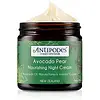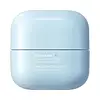What's inside
What's inside
 Key Ingredients
Key Ingredients

 Benefits
Benefits

 Concerns
Concerns

 Ingredients Side-by-side
Ingredients Side-by-side

Water
Skin ConditioningOlivine Extract
Skin ConditioningButyrospermum Parkii Butter
Skin ConditioningGlycerin
HumectantLeptospermum Scoparium Branch/Leaf Oil
TonicMacadamia Ternifolia Seed Oil
EmollientPersea Gratissima Oil
Skin ConditioningCetearyl Alcohol
EmollientCalendula Officinalis Flower Oil
MaskingCocos Nucifera Oil
MaskingLecithin
EmollientTocopherol
AntioxidantHelianthus Annuus Seed Oil
EmollientDehydroacetic Acid
PreservativeBenzyl Alcohol
PerfumingBisabolol
MaskingVitis Vinifera Seed Extract
AntimicrobialBenzyl Benzoate
AntimicrobialBenzyl Salicylate
PerfumingCitral
PerfumingCitronellol
PerfumingLimonene
PerfumingEugenol
PerfumingFarnesol
PerfumingGeraniol
PerfumingIsoeugenol
PerfumingLinalool
PerfumingWater, Olivine Extract, Butyrospermum Parkii Butter, Glycerin, Leptospermum Scoparium Branch/Leaf Oil, Macadamia Ternifolia Seed Oil, Persea Gratissima Oil, Cetearyl Alcohol, Calendula Officinalis Flower Oil, Cocos Nucifera Oil, Lecithin, Tocopherol, Helianthus Annuus Seed Oil, Dehydroacetic Acid, Benzyl Alcohol, Bisabolol, Vitis Vinifera Seed Extract, Benzyl Benzoate, Benzyl Salicylate, Citral, Citronellol, Limonene, Eugenol, Farnesol, Geraniol, Isoeugenol, Linalool
Water
Skin ConditioningGlycerin
HumectantButylene Glycol
HumectantPPG-5 Caprylyl Ether
Skin ConditioningPolyglyceryl-3 Methylglucose Distearate
EmulsifyingMethyl Trimethicone
Skin ConditioningGlyceryl Stearate
EmollientPentaerythrityl Tetraethylhexanoate
EmollientCeramide AP
Skin Conditioning1,2-Hexanediol
Skin ConditioningStearyl Dimethicone
EmollientBis-Hydroxyethoxypropyl Dimethicone
EmollientCetyl Alcohol
EmollientLactobacillus Ferment Lysate
Skin ConditioningCaprylic/Capric/Myristic/Stearic Triglyceride
EmollientPalmitic Acid
EmollientStearic Acid
CleansingPanthenol
Skin ConditioningHydroxyethyl Acrylate/Sodium Acryloyldimethyl Taurate Copolymer
Emulsion StabilisingPropanediol
SolventAcrylates/C10-30 Alkyl Acrylate Crosspolymer
Emulsion StabilisingXanthan Gum
EmulsifyingGlyceryl Caprylate
EmollientDextrin
AbsorbentTromethamine
BufferingEthylhexylglycerin
Skin ConditioningDisodium EDTA
Sorbitan Isostearate
EmulsifyingAllantoin
Skin ConditioningHydrolyzed Hyaluronic Acid
HumectantCeramide NP
Skin ConditioningParfum
MaskingBeta-Glucan
Skin ConditioningCholesterol
EmollientMannitol
HumectantTocopherol
AntioxidantAcetyl Tetrapeptide-11
Skin ConditioningUndaria Pinnatifida Extract
Skin ConditioningWater, Glycerin, Butylene Glycol, PPG-5 Caprylyl Ether, Polyglyceryl-3 Methylglucose Distearate, Methyl Trimethicone, Glyceryl Stearate, Pentaerythrityl Tetraethylhexanoate, Ceramide AP, 1,2-Hexanediol, Stearyl Dimethicone, Bis-Hydroxyethoxypropyl Dimethicone, Cetyl Alcohol, Lactobacillus Ferment Lysate, Caprylic/Capric/Myristic/Stearic Triglyceride, Palmitic Acid, Stearic Acid, Panthenol, Hydroxyethyl Acrylate/Sodium Acryloyldimethyl Taurate Copolymer, Propanediol, Acrylates/C10-30 Alkyl Acrylate Crosspolymer, Xanthan Gum, Glyceryl Caprylate, Dextrin, Tromethamine, Ethylhexylglycerin, Disodium EDTA, Sorbitan Isostearate, Allantoin, Hydrolyzed Hyaluronic Acid, Ceramide NP, Parfum, Beta-Glucan, Cholesterol, Mannitol, Tocopherol, Acetyl Tetrapeptide-11, Undaria Pinnatifida Extract
 Reviews
Reviews

Ingredients Explained
These ingredients are found in both products.
Ingredients higher up in an ingredient list are typically present in a larger amount.
Glycerin is already naturally found in your skin. It helps moisturize and protect your skin.
A study from 2016 found glycerin to be more effective as a humectant than AHAs and hyaluronic acid.
As a humectant, it helps the skin stay hydrated by pulling moisture to your skin. The low molecular weight of glycerin allows it to pull moisture into the deeper layers of your skin.
Hydrated skin improves your skin barrier; Your skin barrier helps protect against irritants and bacteria.
Glycerin has also been found to have antimicrobial and antiviral properties. Due to these properties, glycerin is often used in wound and burn treatments.
In cosmetics, glycerin is usually derived from plants such as soybean or palm. However, it can also be sourced from animals, such as tallow or animal fat.
This ingredient is organic, colorless, odorless, and non-toxic.
Glycerin is the name for this ingredient in American English. British English uses Glycerol/Glycerine.
Learn more about GlycerinTocopherol (also known as Vitamin E) is a common antioxidant used to help protect the skin from free-radicals and strengthen the skin barrier. It's also fat soluble - this means our skin is great at absorbing it.
Vitamin E also helps keep your natural skin lipids healthy. Your lipid skin barrier naturally consists of lipids, ceramides, and fatty acids. Vitamin E offers extra protection for your skin’s lipid barrier, keeping your skin healthy and nourished.
Another benefit is a bit of UV protection. Vitamin E helps reduce the damage caused by UVB rays. (It should not replace your sunscreen). Combining it with Vitamin C can decrease sunburned cells and hyperpigmentation after UV exposure.
You might have noticed Vitamin E + C often paired together. This is because it is great at stabilizing Vitamin C. Using the two together helps increase the effectiveness of both ingredients.
There are often claims that Vitamin E can reduce/prevent scarring, but these claims haven't been confirmed by scientific research.
Learn more about TocopherolWater. It's the most common cosmetic ingredient of all. You'll usually see it at the top of ingredient lists, meaning that it makes up the largest part of the product.
So why is it so popular? Water most often acts as a solvent - this means that it helps dissolve other ingredients into the formulation.
You'll also recognize water as that liquid we all need to stay alive. If you see this, drink a glass of water. Stay hydrated!
Learn more about Water